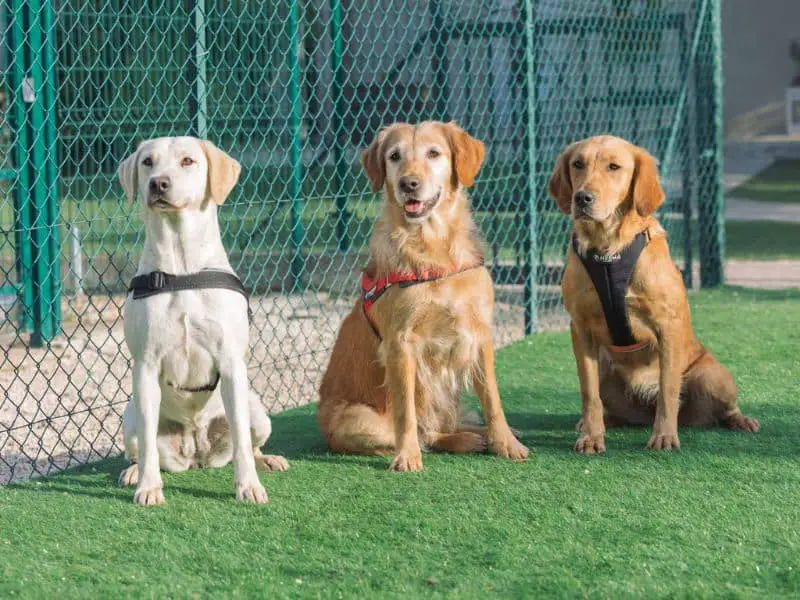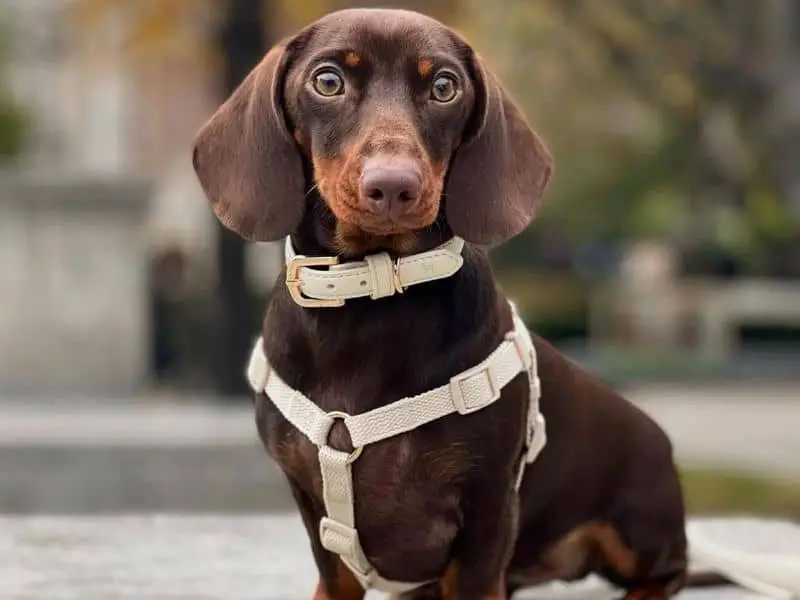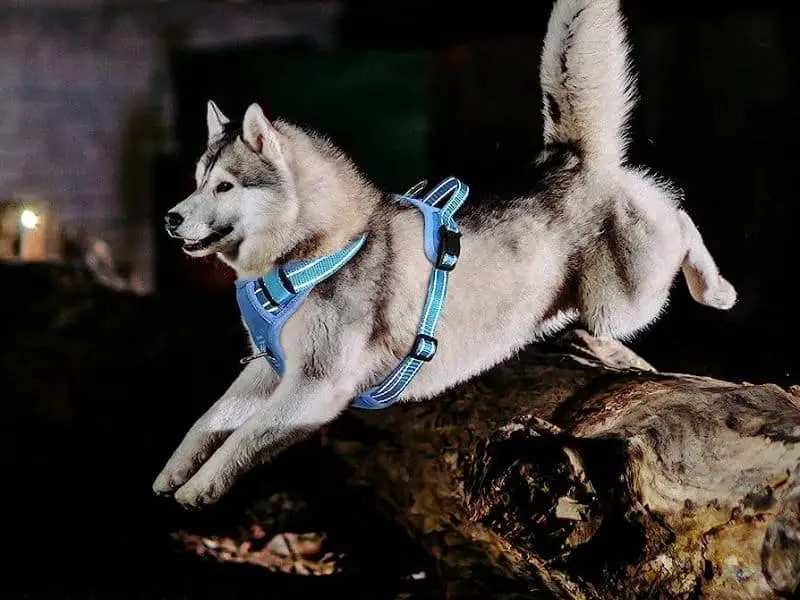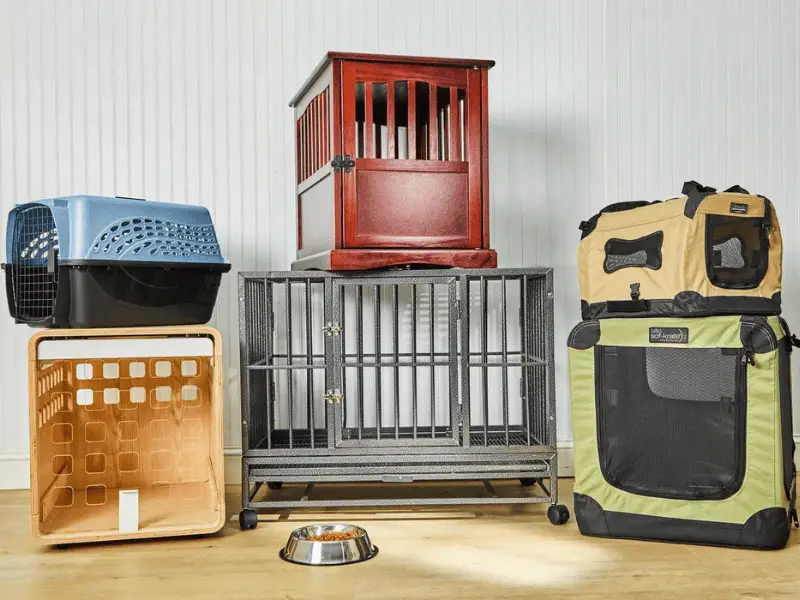Finding the right dog harness size chart by breed is essential for ensuring both security and comfort for your furry friend. In this section, we will explore the importance of selecting the correct dog harness size and how it relates to your pet’s well-being.

Discover the benefits of a well-fitting harness, the potential health issues caused by ill-fitting collars, and how harnesses provide control and comfort during walks.
We will also touch upon various harness styles suitable for different breeds, ensuring you make an informed choice for your canine companion.
Dog Harness Size Chart By Breed
The table includes a generalized dog harness size chart based on breeds and sizes. Please note that individual dogs may vary in size even within a breed, and mixed breeds can be particularly variable. Always measure your dog to find the correct harness size.
To accurately determine the size of a dog harness, you should measure the dog’s girth. This is the circumference of the dog’s chest at the widest point, typically just behind the front legs.
Always refer to the specific size chart provided by the harness manufacturer, as sizes can vary between brands.
Importance of Finding the Right Dog Harness Size
A well-fitting harness offers many advantages for both the dog and the owner. Such as:
- Providing a secure and comfortable fit, stopping any discomfort or irritation.
- Giving freedom of movement with control.
- Distributing pressure evenly across the body, reducing strain on the neck.
- Ensuring the safety, comfort, and well-being of the dog when out walking.
When selecting a harness for your canine, there are certain elements to think about. The breed of the dog determines the most suitable style of harness.
For instance, some breeds may benefit from a figure 8 or over-the-head strap harness due to their body shape and size. Measuring your dog accurately is essential to get the precise size harness.
Taking into account things such as weight fluctuations or growth spurts is important too. By considering these points and selecting a suitable, well-fitting harness based on the dog‘s individual needs, you can improve their walking experience while ensuring their safety and comfort.
A handy tip to remember when fitting your dog’s harness is to leave some flexibility without sacrificing security. It is essential to adjust the straps, clips, and fastenings properly based on your dog’s measurements.
This will stop the harness from being too tight or loose. A harness that is too tight can cause discomfort, while one that is too loose may lead to the dog escaping.
Finding the perfect balance in fit and adjusting as needed ensures maximum security and comfort during walks. Harnesses that don’t fit right can cause health issues for your furry friend.
Health issues caused by ill-fitting collars
Collars that don’t fit right can be hazardous to your pup’s health. Neck injuries, irritation, and discomfort can be caused by a collar that is not the right size. Tight collars can put pressure on the throat, leading to throat or thyroid damage.
Tight collars can also hinder breathing and cause coughing, wheezing, and difficulties swallowing. The voice can even be affected in extreme cases, or trachea can collapse. Getting the right size collar is critical to keep your pup healthy and safe.
Incorrectly fitted collars can also affect your pup’s behavior negatively. If the collar is too loose, the pup can escape during walks and get lost or hurt. If the collar is too tight, it can cause pain and distress.
This can lead to pulling or hostility when on a walk. The right size collar can protect your pup from physical harm and make walking more enjoyable.
Harnesses are an additional option for restraining your pup during walks. They evenly spread the pressure across the chest and shoulders, reducing the risk of injuries. There are different types of harnesses for different breeds.
For instance, figure 8 harnesses are ideal for smaller breeds and step-in padded harnesses are suitable for bigger, more active breeds. By getting the right size harness, you can ensure your pup’s comfort, control, and safety when out and about.
Remember – pick the correct size harness and keep your pup comfy and in control. Avoid chafing at all costs!
How harnesses provide control and comfort during walks
Harnesses are important for control and comfort when walking your pup. They spread the force evenly, so you have better control and balance. Unlike collars, harnesses prevent choking and straining of the neck and throat. Plus, they support the chest and back, reducing pressure.
You can attach the leash to the back or front clip of the harness for more control. Padded harnesses also provide extra comfort for your pup, preventing skin irritation. Different styles of harnesses are available to suit your pup’s breed and needs.

It’s important to measure your pup’s size when choosing a harness. You should consider their weight, age, personality, and lifestyle. Also, adjust the harness straps, clips, and fastening systems correctly for safety and comfort. Re-check and adjust the harness if your pup grows or changes in weight.
Harness styles suitable for different breeds
Choosing the right harness style for your pup is essential. It should provide comfort, and control, and accommodate their unique characteristics.
For breeds with narrow heads, like Greyhounds or Whippets, a figure 8 harness is ideal. This type securely fits around the neck and chest without putting too much pressure on the throat.
An over-the-head strap harness is perfect if your pup is most dog breeds. Straps go over the head and around the chest, distributing pressure evenly when the dog pulls.
A step-in strap harness is great for small and toy breeds like Yorkshire Terriers and Dachshunds. The dog’s legs go through two holes; then adjustable straps are secured around the back.
When selecting a harness style, consider factors such as breed size, body shape, and activity level. Larger breeds may require padded step-in harnesses, while mesh harnesses are great for dogs living in warmer climates or those prone to overheating.
By choosing the right harness style for your pup’s breed, you can ensure optimal comfort, control, and safety.
Measuring Your Dog for a Harness
When it comes to finding the right dog harness, measuring your furry companion accurately is key. This section will discuss the essential measurements for harness sizing, the proper techniques for obtaining accurate measurements, and how to interpret the measurements to ensure a proper fit.
Additionally, we will highlight important factors to consider when choosing a harness for your dog’s security and comfort. So let’s dive in and make sure your pup is snug and safe in their new gear!
Key measurements for harness sizing
Determining the right size for a harness for your pup involves taking measurements. These measurements provide the info to ensure a snug fit and help with control and comfort on walks. By accurately measuring your pup, you can get the right fit and avoid health issues caused by ill-fitting collars.
To help owners find the right size, there’s a table that displays key measurements. The columns include neck circumference, chest circumference, and length from neck to tail. These measurements are vital to finding the best fit.
Looking at the table is easy to determine the right size, without any guesswork.
Different breeds may need different measurements due to their body shape and unique characteristics. It’s best to consider breed-specific recommendations when choosing a harness size.
In addition, consider age, weight fluctuations, and lifestyle when sizing to ensure a comfortable fit that still provides control and security during walks.
Accurate measurement techniques
Accurately measure your pup for a harness? Key measurements to consider include the chest girth, neck circumference, and length from base of neck to base of tail. Take these measurements correctly so you can determine the appropriate size.
Wrap a flexible measuring tape around the widest part of the chest and back, behind the front legs.
Place tape around the neck’s base above the shoulders for the neck circumference. Refer to a sizing chart or guide to interpret measurements and choose a harness size. Breeds may require specific sizes or styles due to body shape and proportions.
Moreover, other factors to consider when choosing a harness are weight, age, activity level, and any needs/preferences the pup may have. A properly fitting harness based on these will contribute to comfort and safety. An ill-fitted collar can lead to health issues – so proper sizing matters!
Interpreting measurements for proper sizing
Sizing a dog harness right is key. A fit harness gives control without restricting movement or hurting the dog. Wrong sizing can cause neck strain, tracheal collapse or even injuries.
To get the correct size, these measurements must be taken: chest girth, neck circumference and sometimes back length.
Breed characteristics and any unique physical attributes must be considered too. When fitting the harness, straps must be snug but not tight. Fasten clips and buckles to prevent escape. Check and adjust fit regularly as dogs may change in weight or size.
Factors to consider when choosing a harness
When selecting a harness for your pup, there are lots of points to think of. An essential one is the harness style. Depending on their particular needs and attributes, various breeds may need different types of harnesses.
For instance, a figure 8 harness may suit breeds that need more control, while an over-the-head strap harness could be more convenient for others.
You should also keep size and fit in mind. It’s essential to make sure the harness fits your pup correctly for their safety and comfort on walks. Taking accurate measurements of their chest circumference, neck size, and weight can help you find the right size. A badly fitting harness can cause pain or even health issues.
The material and build of the harness are important too. The harness should be made of strong material that won’t lose shape or get damaged with regular use. It should also be comfortable for your pup to wear. Also, the construction should be sturdy, with secure fastening systems to ensure it stays in place.
Adjustability is another critical factor. A good harness should have adjustable straps and clips, so you can customize it based on your pup’s body shape and growth. This means you can adjust the harness as needed to give a secure and comfortable fit over time.
Taking all these points into account will assist you in finding the right harness for your furry friend, providing them with comfort, safety, and ease of use when out for a stroll.
Different Types of Dog Harnesses
When it comes to choosing the right dog harness, understanding the different types available is key.
In this section, we will explore a variety of harness styles, including figure 8 harnesses, over-the-head strap harnesses, over-the-head mesh harnesses, step-in strap harnesses, step-in padded harnesses, and suitable harness styles for specific breeds.
So, whether you have a small toy breed or a large working breed, we’ve got you covered with the perfect harness options.
Figure 8 harnesses
The figure 8 harness is a special type of dog harness formed in the shape of an 8. It has many advantages, such as:
- Giving a secure fit
- Distributing the pressure evenly
- Providing control without choking
- Minimizing tangling
- Being suitable for small breeds
It also has adjustable straps to guarantee a perfect fit for different dog shapes and sizes.
The figure 8 harness is perfect for dogs with respiratory issues, or small breeds with delicate necks, as it puts no pressure on the sensitive throat area. An example of this is the story of Max, a Dachshund.
His owner had always used a collar for walks, but noticed Max would often struggle to breathe. After switching to a figure 8 harness, Max’s breathing improved greatly.
This proves how finding the right harness size can greatly affect a dog’s health and safety.
Over-the-head strap harnesses
Mesh over-the-head harnesses provide a snug fit and security for your pup. Their adjustable straps make them suitable for dogs of all sizes. They’re also convenient, easy to put on and take off.
When selecting a harness, consider your dog’s size, breed, and needs. Some need extra padding or support in certain areas, so choose a harness that provides that. Adjust the straps to prevent discomfort and rubbing on the skin.
Did you know? Over-the-head harnesses are recommended for dogs with respiratory issues or neck injuries, as they don’t put pressure on the throat area like traditional collars do. Mesh over-the-head harnesses are also great for breathability and convenience.
Enjoy your walks with your pup!
Over-the-head mesh harnesses
When picking a mesh harness for your pup, size, and breed are key considerations. A snug fit is necessary for comfort and safety. Make sure to check the fit often, especially if your pup has gained or lost weight or grown in size.

Mesh harnesses have several advantages over other harness types. They are easy to put on and provide plenty of ventilation. Plus, they spread pressure evenly across the body. Pick one that fits well and meets your pup’s requirements when buying a harness.
Step-in strap harnesses
Here’s a 6-step guide to using a step-in strap harness!
- Loosen the straps to fit it easily over your dog’s head and body.
- Hold open the harness and have your dog step into it with its front legs.
- Pull the straps up over the shoulders, lying flat against its body.
- Adjust the straps for a snug, comfortable fit around chest and back.
- Make sure there is room for your fingers between the straps and your dog’s body.
- Fasten the clips or buckles securely – not too tight, not too loose.
Remember: straps should not dig into the skin or restrict movement. The American Kennel Club also states that a properly fitted harness is crucial for safety and preventing injury during walks.
Step-in padded harnesses
- Step-in padded harnesses provide extra comfort and security for dogs on walks. To use one, put it on the ground with the padding facing up. Help your pup through the two openings. Lift it, and secure it using the clasp or buckles.
- Make sure it fits properly. The straps should be snug but not tight. Check it often and make adjustments as needed. Especially if your pup gains or loses weight.
- The padding in the step-in harness helps keep pressure away from sensitive areas like the chest and shoulders. This is especially helpful for pups with delicate skin or those prone to irritation. Get the right harness, and your four-legged buddy can stay comfortable and safe on their walks!
Suitable harness styles for specific breeds
Harnesses come in various styles and designs to fit breeds’ needs. Smaller breeds can benefit from a figure 8 harness – secure and cozy, avoiding strain on their neck.
Medium-sized dogs may prefer an over-the-head strap harness, providing convenience and control during walks. Bigger breeds can go for an over-the-head mesh harness – allowing breathability and flexibility yet still secure.
So, when selecting a harness style for a breed, its size, and unique needs must be taken into account.
Adjusting and Fitting Your Dog’s Harness
Ensuring your dog’s harness fits correctly is crucial, not only for their comfort but also their safety. Special attention and focus should be on:
1. The Importance of Proper Fitting
2. Adjusting Straps and Fastening Systems
3. Techniques for Putting On Various Types of Harnesses
4. Achieving the Right Balance of Tightness
5. Adjusting the Harness Over Time
With these points in mind, you’ll be well-equipped to find and maintain the perfect harness fit for your furry friend.
Importance of proper fitting for safety and comfort
A well-fitting dog harness is a must for your pup’s safety and comfort. Badly fitting harnesses can cause neck strain and breathing problems. A good fit provides control and support during walks so that you can guide your pooch easily.
Different breeds need different harnesses. Get accurate measurements of your pup’s chest girth, neck circumference, and back length. Then, compare them to a size chart from the manufacturer.
There are various types of harnesses in the market. Figure 8s offers a secure fit. Over-the-head strap harnesses are easy to take on and off. Mesh harnesses are breathable in hot weather. Step-in straps or padded harnesses are great for dogs who pull leashes.
Adjust straps, clips, and fastening systems according to your pup’s size and shape. The method of fitting a harness varies. Balance tightness and comfort shouldn’t be too tight or loose. Remember to adjust the fit regularly as your pup grows or if its weight changes.
Adjusting straps, clips, and fastening systems
Properly adjusting a dog harness’s straps, clips, and fastening systems is essential for your pup’s safety and comfort. Unfitted harnesses can cause discomfort and may even result in health risks.
Thus, it’s important to understand how to adjust these components correctly for the perfect fit.
- Firstly, take note of the key measurements for harness sizing. These measurements include the chest circumference, neck circumference, and back length of your dog. Accurate measurements are vital to get the right size harness.
- Adjusting the straps, clips, and fastening systems involve a 5-step process:
- Step 1: Loosen all straps on the harness.
- Step 2: Put the harness on your dog by slipping it over its head or stepping them into it.
- Step 3: Position the harness comfortably on their body without restricting movement.
- Step 4: Tighten the straps gradually, starting with the largest ones.
- Step 5: Make sure all clips are secure but not too tight.
- It’s worth noting that different types of harnesses may have varying adjustment methods. Some have buckles or sliders for easy strap adjustment, while others require more intricate techniques. Therefore, understanding how to adjust each type is key for optimal security and comfort during walks.
By following these guidelines, you can ensure your pet’s safety and comfort during walks. Taking special care in ensuring correct fitting also prevents potential health problems caused by ill-fitting harnesses.
Methods of putting on different types of harnesses
Before you start, make sure you’ve picked the right harness for your pooch’s size, breed, and needs. Different breeds may need certain kinds of harnesses for maximum comfort and control.
For over-the-head strap harnesses, slide them over your pup’s head. The D-ring should be in the back and facing up.
To put on a Figure 8 harness, loop one strap around your dog’s chest, then cross it over their back. Loop the other strap around their chest too. Fasten both straps to the D-ring.
Mesh harnesses are placed over your pup’s head like strap harnesses. Make sure to adjust straps and clips to fit snugly without restricting movement.
Step-in strap harnesses need your dog’s front legs put into two openings of the harness. Pull it up to their back before clipping or buckling.
These are general instructions. For specific instructions, read the manufacturer or seller’s notes. This will ensure proper use and fit, so your pup is safe and comfy during walks.
Harnesses should fit properly. Ill-fitting or wrongly worn harnesses can harm or hurt your pup. Every dog is unique, so measure them and choose the right style for their breed, personality, age, and lifestyle. Adjust it if their weight or height changes.
Finding the perfect harness fit is like walking a tightrope – balanced between comfort and security.
Balancing act of harness tightness
Discovering the ideal balance of tightness when fitting a dog harness is essential for guaranteeing both safety and comfort.
It’s important to adjust the harness straps properly, so it’s not too loose – which could lead to them slipping out – or too tight, which can cause discomfort or restrict their movement.

Achieving this balance requires thoughtful consideration and knowledge of the dog’s size, breed, and specific needs.
- Step 1: Measurement
To get the optimal balance of tightness, start by precisely measuring your dog for the harness. This includes finding out key measurements like chest circumference and neck size. By accurately measuring your pup’s dimensions, you can make sure you pick the right size harness. - Step 2: Proper Fitting Techniques
When putting on the harness, ensure you follow the proper fitting techniques for the harness type. This may involve adjusting straps or using clips and fastening systems correctly. Properly fitting a harness ensures it sits comfortably on your pup without causing any chaffing or irritation. - Step 3: Adjust as Needed
Remember that achieving the perfect balance of tightness might require some adjustments over time. Dogs’ sizes can change due to weight fluctuations or growth spurts, so it’s important to check and readjust strap lengths when needed regularly. This will help them keep a secure fit without compromising their comfort.
Overall, finding the right balance of tightness when fitting a dog harness involves exact measurement techniques, proper fitting techniques specific to the type of harness being used, and regular adjustments based on size or weight changes.
Considering these factors will ensure your dog’s safety and comfort during walks while also providing you with control and peace of mind.
Adjusting harnesses for changes in weight or growth
For the best fit and comfort of your pup’s harness, it’s key to adjust it for any changes in size or weight. Here are five steps:
- Check fit: Check regularly how the harness fits on your dog’s body. Make sure there’s no pressure on chest or shoulders and check for movement.
- Measure again: If changes in size or weight occur, measure using the key measurements. This’ll help decide if a new size is needed.
- Loosen/tighten straps: Adjust straps depending on if pup has gained or lost weight. Loosen if bigger or tighten if slimmer.
- Use attachments: Some harnesses come with adjustable attachments for more flexibility.
- Monitor fit regularly: Check and adjust the harness as necessary. Reassess the fit every few months or when changes are visible.
These steps will help ensure your pup’s harness fits correctly, providing comfort and safety during walks.
Take into account breed-specific growth patterns and body shape variations. Certain breeds may need more frequent adjustments due to rapid growth in certain stages.
Environmental factors such as increased activity or diet can also affect weight and shape. Monitor and adjust the harness to keep a secure and comfortable fit for your pup. Prioritize safety with these tips!
Additional Tips and Safety Considerations
When it comes to ensuring the safety and comfort of your furry companion, some additional tips and safety considerations shouldn’t be overlooked.
From choosing the right harness based on your dog’s unique qualities to understanding the potential health problems caused by incorrect fitting and taking precautions to enhance their walking experience, this section has all the vital information you need for a secure and comfortable harness selection.
Choosing the right harness based on the dog’s size, age, personality, and lifestyle
Selecting the right harness for your pup necessitates considering factors like size, age, personality, and lifestyle. Weighing up these aspects helps to guarantee your dog’s comfort, safety, and proper control on walks.
- Size: Selecting a harness that fits your dog’s size properly is important. A good-fitting one grants optimal control while avoiding discomfort or rubbing.
- Age: Puppies may need adjustable harnesses to accommodate their growth. Older dogs may benefit from harnesses that evenly spread pressure, reducing joint strain.
- Personality and Lifestyle: Considering your dog’s temperament and activity level when selecting the harness is essential. Some dogs may need extra padding or security features for added comfort and control.
Moreover, different breeds have special needs when it comes to harness styles. Establishing the most suitable type of harness for your dog is vital in providing them support and comfort when out on walks.
Choosing the correct harness for your pup involves factoring in size, age, personality, and lifestyle. By taking these parameters into account and picking the right harness style for their breed, you can ensure your furry companion has a relaxed and secure experience on outings.
Potential health problems caused by incorrect harness fitting
A poor-fitting dog harness can cause health issues. It may cause irritation, chafing, and rubbing on the skin. This can lead to skin infections. It also puts strain on the neck, throat, and spine of the dog.
This might cause long-term musculoskeletal issues. A badly-fitted harness can restrict breathing and movement, which can cause respiratory problems and limited mobility during walks.
A fit that is too loose or a tight harness can cause health issues too. A loose harness increases the risk of tangling or tripping during walks. Too tight harnesses put too much pressure on areas like the chest or shoulders.
This can cause discomfort and improper blood circulation. Over time, this can lead to muscle strain and a lack of oxygen to vital organs.
It is important to note that each breed has different body shapes and sizes. This makes it important to choose a harness designed for their needs.
Harnesses not the correct size can contribute to improper fitting and subsequent health problems. Therefore, it is important to consider breed-specific factors when selecting a harness.
Precautions to prevent harm and ensure comfort and safety during walks
Precaution is key for a safe and comfortable walk with your pup. Select the right harness size, considering your dog’s needs. Measure accurately before purchase and adjust the harness correctly on your pup’s body. That way you can both have an enjoyable experience!
Conclusion on the Importance of Dog Harness Size Chart by Breed
A dog harness size chart is essential for pet owners. It informs decisions, taking into account the unique physical characteristics of different breeds. This reference data helps ensure the harness fits properly and won’t cause discomfort or hinder movement.
It eliminates guesswork by considering the measurements of breeds. Attention to detail ensures a secure and comfortable fit for the dog. It also highlights breed-specific needs, like if they pull or have prominent shoulders. This knowledge helps select a harness that meets individual needs.
One dog owner shared that she tried different sizes without success, but after consulting the size chart, she found the right size. This story demonstrates how useful the dog harness size chart is. It avoids frustration and provides optimal security and comfort for pets.
Security and Comfort: Deciphering the Dog Harness Size Chart by Breed
- It is important to measure your dog’s chest, neck, and breed to determine the correct size of the harness.
- There are harnesses available with plastic buckles that are easier to fasten and metal buckles that are sturdier, making them better for energetic dogs or car travel.
- Over-head harnesses are easier to put on, while step-in harnesses offer more padding and adjustment options.
- Harnesses distribute weight and do not tighten around the throat like collars, making them more comfortable for dogs.
- In Australia, it is a legal requirement to secure dogs with a harness when traveling in a car, and there are harnesses available that can be clipped onto seat belts.




Leave a Reply